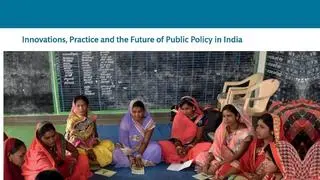The term ‘licence-permit Raj’, with all its pejorative connotations, is now firmly ensconced in the Indian political lexicon. But few know who coined it – it was C Rajagopalachari, freedom fighter, twice Chief Minister of erstwhile Madras State, Independent India’s first Governor General, and more importantly founder of Swatantra Party.
Aditya Balasubramanian’s ‘Toward a Fee Economy – Swatantra Party and Opposition Politics in Democratic India’, maps the rise and fall of this party and more importantly how it created a space for Opposition politics in a newly independent India at a time of Congress dominance.
Balasubramanian belongs to the growing band of young historians writing about independent India (Nikhil Menon, Rohit De, Madhav Khosla) and this book is a valuable addition to that genre.
The book portrays a wide array of personalities, long forgotten now, who were responsible for laying the groundwork for Libertarian politics in India whose bedrock was free economy at a time when economic planning was the ruling ideology.
Balasubramanian begins the story of Indian libertarianism with Ranchoddas Lotvala, a successful Bombay businessman, whose Libertarian Social Institute, played a key role in propagating libertarian ideas through seminars, pamphlets and magazines. KM Munshi, freedom fighter and member of the Constituent Assembly, was also a key figure in the Indian Conservative movement. His Bharthiya Vidya Bhavan and the magazine Bhavan’s Journal weaved a narrative of Hindu revivalism, anti-Communism and opposition to Nehru’s statist vision of economic development which Munshi believed paved the way for totalitarianism.
Rajaji, key figure
C Rajagopalachari (Rajaji) is the central figure in Balasubramanian’s narrative. The author sketches Rajagopalachari’s political journey, his sidelining by the Congress and his political rejuvenation after the founding of Swatantra Party. Rajagopalachari blended Indian conservatism with anti-communism, neo-liberal rhetoric, and defence of private property into a political party.
Rajagopalachari was rooted in Indian culture and the mofussil played a vital part in his political narrative. He was a prolific writer, his books on Ramanayana and Mahabharata were hugely popular. His short stories gave a fascinating insight into his views on inequality, prohibition, temperance and social reform.
But Balasubramanian tellingly points towards Rajagoplachari’s indifferent attitude towards caste and social inequalities. For Rajagopalachari the petty corruption spawned by a bloated bureaucracy was a more pressing issue than inequality. He edited the Swarajya magazine which
was an important vehicle in disseminating Libertarian views. Tamil magazine Kalki played a vital role in connecting the Tamil audience to his views.
Economist BR Shenoy is another important figure in the Indian conservative journey and Balasubramanian devotes a considerable part of the book on him. Shenoy was a trenchant critic of the Second Five-Year Plan and devoted to the free market ideology. Rajagopalachari leaned heavily on Shenoy to form his views on the economy and popularized Shenoy’s opinions in Swarajya and Kalki.
Swatantra, rise and fall
The Swatantra Party was launched in 1959. It attracted supporters from a wide variety communities and castes. Balasubramanian notes how upwardly mobile agrarian castes eyeing opportunities in trade, transport and small industry were attracted to Swantantra’s free economy ideology.
It also attracted support from former bureaucrats of the more progressive Princely states – Baroda, Travancore, Mysore.
Apart from Rajagoplalachari, there were three other important personalities – NG Ranga, Minoo Masani and Bhailalbhai Patel – in Swatantra Party and Balasubramanian provides a fascinating biographical sketch of them.
Ranga was a freedom fighter who was instrumental in rallying peasant support for Gandhiji’s freedom movement, especially in the Telugu speaking areas of South India. But by the 1950s he had broken away from the Congress and though he supported Zamindari abolition he was alarmed by the more radical Congress proposals on tenancy rights. Balasubramanian also talks about how, like Rajagopalachari, Ranga effortlessly straddled the intellectual worlds of English and Indian language (Telugu) ‘publics’. A prolific writer, Ranga was also keenly involved in the global African-Asian anti-colonial movement.
Bhailalbhai Patel was instrumental in organizing dairy farmers in Gujarat (Amul), and setting up of the Sardar Patel University, which conducted extensive agriculture surveys. He opposed land ceilings Act as he believed it would destroy peasant culture and he was a big supporter of small business entrepreneurship.
Minoo Masani in contrast to Ranga and Patel was an urbane Bombay cosmopolitan who had great faith in Constitutional and Parliamentary processes.
Despite their diverse backgrounds together they forged a positive economic and political vision for India, which went beyond a mere critique of Congress policies, centered on free economy, small business and small peasant proprietors.
Swatantra Party’s best performance was in the 1967 elections, which Balasubramanian perceptively notes proved to be illusory. By 1971, the party had disintegrated partly due to in-
fighting and partly due to the fast-changing political scenario. But Balasubramanian argues that Swatantra’s record should not be solely judged by its electoral performance.
By filing cases in Supreme Court questioning the Constitutional validity of bank nationalization, the 17th Constitutional amendment, where States were given the right to bring in land ceiling legislation in non-Zamindari areas without judicial review, and abolition of privy purses – Swatantra played a big role in bringing the higher judiciary into the political scene.
Balasubramanian also highlights the shortcomings of Swatantra – apathy towards caste and gender inequalities, minority issues and sorely lacking an Indian idiom.
The book ends by briefly exploring the possibility of the revival of a Swatantra-like party in today’s India. Balasubramanian’s musings over a secular opposition party wedded to the cause of small industry and agriculture, drawing on the support of the growing middle classes that shuns of religious majoritarianism may seem Utopian. But it never hurts to dream.
Book details
Title: Toward a Free Economy: Swatantra and Opposition Politics in Democratic India
Author: Aditya Balasubramanian
Publisher: Princeton University Press
Price: ₹799








Comments
Comments have to be in English, and in full sentences. They cannot be abusive or personal. Please abide by our community guidelines for posting your comments.
We have migrated to a new commenting platform. If you are already a registered user of TheHindu Businessline and logged in, you may continue to engage with our articles. If you do not have an account please register and login to post comments. Users can access their older comments by logging into their accounts on Vuukle.